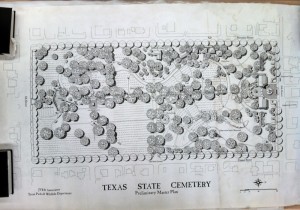
The Alexander Architectural Archive is pleased to share this gem for National Landscape Architecture Month. The Texas State Cemetery Preliminary Master Plan is part of the James G. Reeves Collection. In the Master Plan, Reeves writes:
This plan strives to create a feeling of reverence, respect, dignity, and honor for those buried here and the people of Texas….The intent of this redevelopment is to create a cemetery worthy of our proud history and culture in Texas. This plan hopes to instill a “soul,” a reverence, to the ground that holds the remains of notable Texans that helped first define a republic and then a state. This plan aspires to affirm that this ground is sacred to Texans,..to Texans of all races, creeds, and ages. (Texas State Cemetery Master Plan, JVR & Associates and Texas Parks and Wildlife Department, January 1995, pg. 2)
There are several files associated with the Texas State Cemetery in the James G. Reeves Collection. The collected materials include contracts, correspondence, meeting notes, collected research materials, and the Master Plan prepared by JVR & Associates and the Texas Parks and Wildlife Department. The Master Plan includes not only recommendations for landscape and architectural features but also a copy of the Project Nomination Form for the State Wide Transportation Enhancement Program.
The two aspects of the collection that I found particularly interesting were the correspondence and the collected research for this project. From these materials, one can begin to form a picture regarding Reeves’s involvement and also his process. For example, there is a road map that had been refolded to highlight the location of the cemetery, and Reeves marked the spot with an arrow. Reeves’s handwritten notes that eventually became more formalized documents are also included. In some of the notes, it is apparent that Reeves was unsure about the greenhouse and proposed pond. In the Master Plan, however, it was included though with a potentially limited future (Texas State Cemetery Master Plan, JVR & Associates and Texas Parks and Wildlife Department, January 1995, pg. 14).
As a recent transplant to Austin, I was not aware that we had a State Cemetery until today. I am curious to see how the Master Plan as proposed by James G. Reeves was developed on the site. And if anyone should make it there before me, I encourage you to use the materials established by American Society of Landscape Architects to share the Texas State Cemetery with others!
